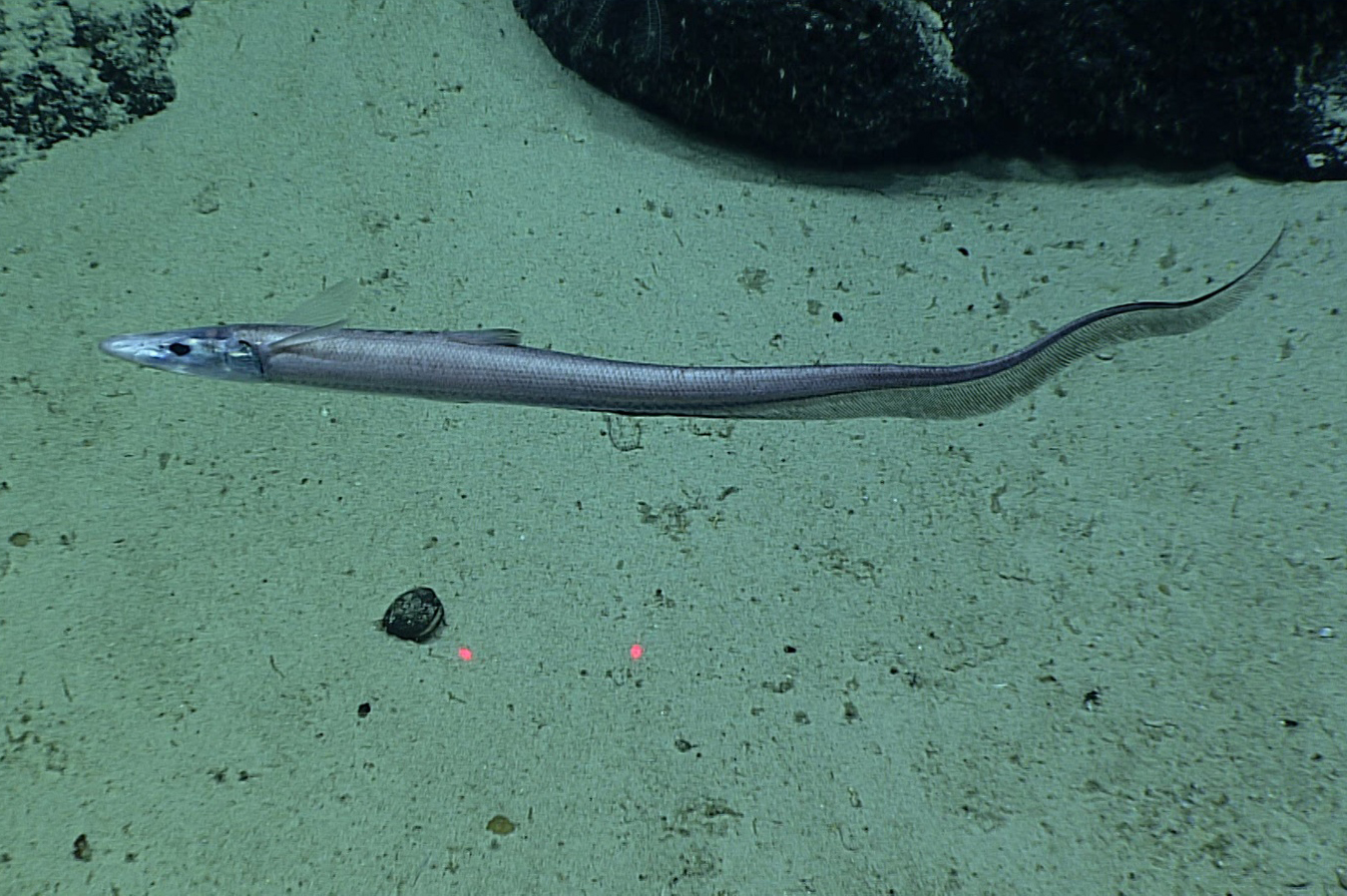Allied Halosaur, Aldrovandia affinis (Günther 1877)
Other Names: Gilbert's Halosaur, Gilbert's Halosaurid Fish

An Allied Halosaur, Aldrovandia affinis, photographed by an ROV. Source: NOAA Okeanos Explorer. License: CC by Attribution-NonCommercial-ShareAlike
Summary:
A pale greyish to pale brown or alnost white halosaur with a silvery head, dark brown pigment on the gill cover, lower head, basal anal fin, tail, and ventral midline, inside mouth very dark, black pyloric caecae, a white anus surrounded by a dark ring, and an unpigmented lateral-line canal.
Video of a halosaur in the Gulf of Mexico, depth 1600 m.
Video of a halosaur in the Gulf of Mexico, depth 1600 m.
Cite this page as:
Bray, D.J. 2022, Aldrovandia affinis in Fishes of Australia, accessed 03 Jul 2025, https://fishesofaustralia.net.au/home/species/2045
Allied Halosaur, Aldrovandia affinis (Günther 1877)
More Info
|
Distribution |
West of Perth, Western Australia, to SW of Ashmore Reef in the Timor Sea, and the northern Coral Sea, Queensland, to off eastern Tasmania; also Christmas Island territory in the eastern Indian Ocean, and the Lord Howe Rise and Norfolk Ridge in the Tasman Sea. Elsewhere the species is circumglobal on the continental slope in tropical and temperate seas, except for the eastern Pacific. |
|
Features |
Dorsal fin 11-13, Pectoral fin I,11-14; Pelvic fin I,7-9; Gill rakers 13-15 (total first arch); Lateral line scales 13-17 (to pelvic fins), 25-31 (to anus), scales above lateral line 13-16, scales around belly usually 7; Pyloric caecae 6-9 (in single row); Branchiostegal rays 10-11. Body very elongate, moderately compressed; snout long, pointed, preoral portion of snout about 2-2.5 times in total snout length; mouth relatively small; palatine tooth patches joined at midline. Head and opercle without scales; lateral-line scales enlarged, lateral line scales two times larger than the body scales, continuous with each other. Dorsal-fin origin over or very slightly behind base of pelvic fin; first dorsal-fin ray unsegmented, very short, vestigial; pelvic fin insertion only slightly anterior to dorsal-fin origin. much shorter than second dorsal-fin ray. |
|
Size |
|
|
Feeding |
Feeds on benthic invertebrates including polychaete worms, pelecypods and amphipods. |
|
Etymology |
The specific name is from the Latin affinis (= related) in reference to the similarity of this species to Aldrovandia rostratus and Halosaurus ovenii as described by Günther: "Otherwise there is the greatest similarity between this species, Halosaurus rostratus and H. ovenii." |
|
Species Citation |
Halosaurus affinis Günther 1877, Annals and Magazine of Natural History 4 20(56): 444. Type locality: South of Japan, 34°N, 138°E, Challenger station 235, depth 565 fathoms. |
|
Author |
Bray, D.J. 2022 |
|
Resources |
Allied Halosaur, Aldrovandia affinis (Günther 1877)
References
Barros-García, D., Froufe, E., Bañón, R., Arronte, J.C., de Carlos, A. 2018. Phylogenetic analysis shows the general diversification pattern of deep-sea notacanthiforms (Teleostei: Elopomorpha). Molecular Phylogenetics and Evolution. 124: 192-198, https://doi.org/10.1016/j.ympev.2018.03.007.
Günther, A. 1877. Preliminary notes on new fishes collected in Japan during the expedition of H.M.S. Challenger. Annals and Magazine of Natural History 4 20(56): 433-446 See ref at BHL
Last, P.R., Pogonoski, J.J., Gledhill, D.C. White, W.T. & Walker, C.J. 2014. The deepwater demersal ichthyofauna of the western Coral Sea. Zootaxa 3887 (2): 191–224
McDowell, S.B. 1973. Suborder Halosauroidei, family Halosauridae. in Cohen, D.M. (ed.) Fishes of the western North Atlantic. Memoir. Sears Foundation of Marine Research 1(6): 32-123 figs 6-13 See ref at BHL
Paulin, C.D. & Moreland, J.M. 1979. Halosauridae of the south-west Pacific (Pisces: Teleostei: Notacanthiformes), New Zealand Journal of Zoology 6(2): 267-271, https://doi.org/10.1080/03014223.1979.10428363
Smith, D.G. 1999. Families Halosauridae, Notacanthidae, Lipogenyidae, Anguillidae, Moringuidae, Chlopsidae, Myrocongridae. pp. 1625-1642 in Carpenter, K.E. & Niem, V.H. (eds). The Living Marine Resources of the Western Central Pacific. FAO Species Identification Guide for Fisheries Purposes. Rome : FAO Vol. 3 pp. 1397-2068.
Smith, D.G. 2015. Aldrovandia affinis. The IUCN Red List of Threatened Species 2015: e.T190356A1949015. https://dx.doi.org/10.2305/IUCN.UK.2015-4.RLTS.T190356A1949015.en. Downloaded on 26 August 2020.
Stewart, A.L. & Struthers, C.D. 2015. Families Halosauridae, Notacanthidae. pp. 206-217 in Roberts, C.D., Stewart, A.L. & Struthers, C.D. The Fishes of New Zealand. Wellington : Te Papa Press Vol. 2 pp. 1-576.
Sulak, K.J. 1986. Halosauridae. pp. 593-598 in Whitehead, P.J.P., Bauchot, M.-L., Hureau, J.-C. & Tortonese, E. (eds) 1986. Fishes of the North-eastern Atlantic and the Mediterranean. Paris : UNESCO Vol. 2 pp. 517-1007.
Williams, A., Last, P.R., Gomon, M.F. & Paxton, J.R. 1996. Species composition and checklist of the demersal ichthyofauna of the continental slope off Western Australia (20–35º). Records of the Western Australian Museum 18: 135-155
Yeh, H.-M., Lee, M.-Y. & Shao, K.-T. 2006. Three new records of Halosaurid fishes (Pisces: Halosauridae) from the deep waters adjacent to Taiwan. Journal of the Fisheries Society of Taiwan. 33(4): 345-355.






